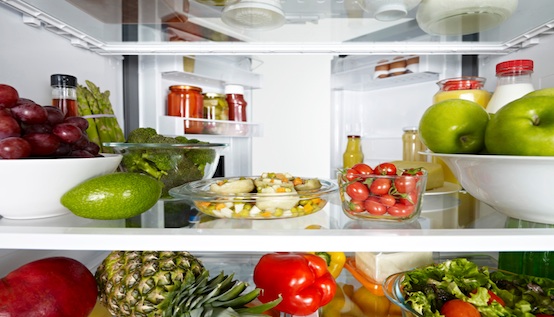
When summer farmer’s markets start filling up, it’s easy to buy too much of a good thing. Or at least, too much for your family to eat before it goes bad.
In fact, Americans throw out 14% of the food they buy, not counting table scraps and leftovers, according to government estimates. But you can easily cut that figure back.
Step 1: Become a better meal planner, which allows for better assessments of how much to buy.
Step 2: Organize your pantry and refrigerator to better showcase ingredients, so that lunch meat never gets lost in the back of the fridge.
Step 3: Figure out the typical shelf life for items you buy, so you know what’s on the critical must-cook list, and what can wait until tomorrow.
For help, try our handy (updated) storage guide below, compiled with data from the USDA, SeriousEats.com, Massachusetts Department of Agricultural Resources, Food52, LifeHacker, FoodSafety.gov, MealsMatter.org, Self magazine and the Food Marketing Institute, among other sources:
Meats
Beef
Store on the bottom shelf in the fridge. As a general rule of thumb, ground meat keeps well for one to two days, and roasts and steaks are safe for three to five days.
Poultry
Store on the bottom shelf in the fridge, with a few paper towels underneath to catch any drips. Keep no more than one to two days.
Fish
Store in the coldest part of the fridge for no more than two days, according to the University of Arizona. Even there, it’ll keep better on a bed of ice.
Pork
Store on the bottom shelf in the fridge. Per USDA guidelines, fresh pork liver and other organ meats can be safely refrigerated for one to two days; roast, steaks, chops and ribs for three to five days.
Prepared Meats
Once opened, a package of hot dogs can be safely refrigerated for up to a week. (Unopened packs can last for up to two weeks.) Deli-sliced lunch meats stay fresh for three to five days, and bacon, up to seven days.
Dairy
Milk
Keep milk and other dairy items at the back of the fridge’s top shelf, where the temperature is more constant. That keeps them fresher longer.
Cheese
Wrap in waxed paper and then place in a plastic bag. Stored in the fridge, it can last five to eight days.
Eggs
Don’t use the handy egg-specific door storage. Store in their carton, on a fridge shelf, where they can last up to five weeks.
Produce
Apples
Store on the counter. Move any uneaten apples to the refrigerator after seven days. In the fridge or out, don’t store near most other uncovered fruits or vegetables — the ethylene gases produced by apples can ruin them (making carrots bitter, for example). The exception: if you want to ripen plums, pears and other fruits quickly, put an apple nearby for a day or so.
Artichokes
Refrigerate in the vegetable crisper whole for up to two weeks.
Asparagus
Store upright in the refrigerator in a plastic bag with either an inch of water or with a damp towel wrapped around the base, just like you would have flowers in a vase. They’ll last three to four days that way.
Avocados
Ripen on the counter. Can be stored in the refrigerator for three to four days once ripe.
Bananas
Store on the counter. Refrigerate only when ripe — they’ll last for another two days or so.
Beets
Remove green tops an inch or two above the crown. Refrigerate beets in a plastic bag to prevent moisture loss, which leads to wilting. (They’ll last seven to 10 days.) Refrigerate greens separately, also in a plastic bag. Best in the vegetable crisper.
Berries
Grower Driscoll’s recommends refrigerating berries in the crisper, unwashed and in their original container. Blueberries and strawberries should keep for five to seven days; more fragile raspberries and blackberries up to two days.
Broccoli
Refrigerate in the vegetable crisper in a sealed plastic bag. It’ll keep for three to five days.
Carrots
Refrigerate in the vegetable crisper in a sealed plastic bag for up to three weeks.
Cauliflower
Refrigerate in the vegetable crisper, stem side down, in a sealed plastic bag. It’ll last three to five days.
Celery
Refrigerate in the vegetable crisper one to two weeks in a sealed bag. Keep in the front of the refrigerator, where it’s less apt to freeze.
Citrus fruits
Store oranges, lemons, limes, and grapefruit on the counter. They can last up to two weeks.
Corn
Refrigerate ears still in the husk. They’ll last up to two days.
Cucumbers
Refrigerate, either in the crisper or in a plastic bag elsewhere in the fridge. They’ll last four to five days.
Garlic
Store in the pantry, or any similar location away from heat and light. It’ll last up to four months.
Green beans
Refrigerate in the vegetable crisper in a plastic bag for three to four days.
Green onions
Refrigerate in the vegetable crisper for up to two weeks.
Herbs
Fresh herbs can last seven to 10 days in the refrigerator. Store in air-tight containers with a damp paper towel on the top and bottom.
Leafy greens
Refrigerate unwashed in the vegetable crisper. Full heads will last five to seven days that way, instead of three to four days for a thoroughly drained one. Avoid storing in the same drawer as apples, pears or bananas, which release ethylene gases that act as a natural ripening agent.
Mushrooms
Take out of the package and store in a paper bag in the refrigerator, or place on a tray and cover with a wet paper towel. They’ll last two to three days.
Onions
Stored in the pantry, away from light and heat, they’ll last three to four weeks.
Peaches
Ripen on the counter in a paper bag punched with holes, away from sunlight. Keep peaches (as well as plums and nectarines) on the counter until ripe, and then refrigerate. They’ll last another three to four days.
Pears
Store on the counter, ideally, in a bowl with bananas and apples, and then refrigerate after ripening. They’ll last another three to four days.
Peas
Refrigerated in the vegetable crisper in a plastic bag perforated with holes, they’ll last three to five days.
Peppers
Refrigerated in the vegetable crisper, they’ll last four to five days.
Potatoes
Store them in the pantry away from sunlight and heat, and they’ll last two to three months.
Radishes
Refrigerate in the vegetable crisper. They’ll last 10 to 14 days.
Summer squash
Refrigerate in a perforated plastic bag. They’ll last four to five days.
Tomatoes
Spread them out on the counter out of direct sunlight for even ripening. After ripening, store stem side down in the refrigerator and they’ll last two to three days.
Tropical fruit
Mangoes, papayas, pineapples and kiwi fruit should be ripened on the counter.
Watermelon
Kept at room temperature on the counter, it’ll last up to two weeks.
Winter squashes
Store on the counter for up to two weeks.
Thanks, Mint!







